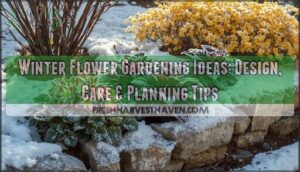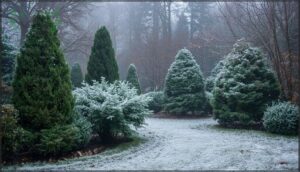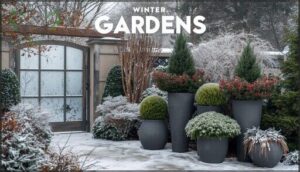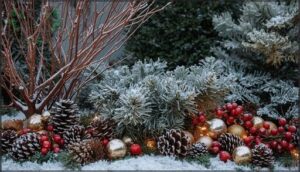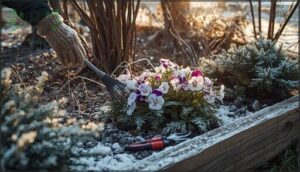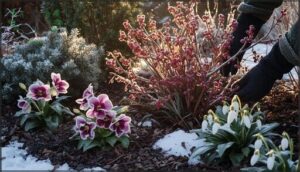This site is supported by our readers. We may earn a commission, at no cost to you, if you purchase through links.
Most gardeners resign themselves to bleak, colorless landscapes once the first frost hits, but winter doesn’t have to mean dormancy. Cold-hardy blooms like hellebores, winter jasmine, and ornamental kale thrive when temperatures drop, transforming frozen beds into unexpected showcases of crimson, gold, and deep purple.
The secret lies in strategic plant selection and proper preparation—protecting root zones with mulch, choosing varieties bred for freezing conditions, and positioning plants where winter sun can reach them.
With the right winter flower gardening ideas, you can design beds that resist the cold instead of surrendering to it, creating a garden that refuses to quit when other landscapes fade to brown.
Table Of Contents
- Key Takeaways
- Winter Garden Preparation Tips
- Choosing Flowers for Winter Interest
- Winter Garden Design Ideas
- Care and Maintenance of Winter Flowers
- Benefits of Winter Flower Gardening
- Frequently Asked Questions (FAQs)
- Do flowers make a good winter garden?
- What makes a beautiful winter garden?
- Are these winter flowering plants winter hardy?
- Can a Winter Garden be a summer garden?
- Is winter gardening a good idea?
- What flowers go well with winter flowers?
- What is the best flower to grow in winter?
- How to make flower beds look good in winter?
- What flower will bloom all year round?
- What flowers can still bloom in the winter?
- Conclusion
Key Takeaways
- Winter gardening succeeds through strategic plant selection of cold-hardy species like hellebores, winter jasmine, and ornamental kale that thrive in freezing temperatures rather than merely surviving them.
- Proper preparation—applying 2-3 inches of mulch after ground freeze, deep watering before frost, and positioning plants for winter sun exposure—transforms dormant beds into vibrant displays that resist harsh conditions.
- Winter gardens deliver measurable benefits beyond aesthetics, including 17% higher happiness scores during cold months, critical pollinator support when natural food sources vanish, and properties that sell 12 days faster due to year-round appeal.
- Low-maintenance options like drought-tolerant heather and hardy witch hazel require minimal intervention while providing continuous color, making winter gardening accessible even for time-strapped gardeners who want seasonal beauty without demanding upkeep.
Winter Garden Preparation Tips
Getting your garden ready for winter doesn’t have to feel like a battle against the elements. Think of it as tucking your plants in for a long nap—some need more blankets than others, and knowing which is which makes all the difference.
Here’s how to assess what you’ve got, protect what needs protecting, and set the stage for a garden that survives winter and comes back stronger.
Assessing and Protecting Existing Plants
Before winter hits hard, you need to know which plants can handle the cold and which ones need backup. Start by checking each plant’s cold hardiness rating against your zone’s lowest temps.
Then take action:
- Water deeply before the first frost to boost resilience and prevent desiccation
- Apply 2-3 inches of mulch around root zones for insulation
- Wrap exposed broadleaf evergreens in burlap for wind protection
To further protect your plants, consider the benefits of regular watering practices.
Overwintering Tender Annuals and Tropicals
Your tender annuals and tropicals won’t survive outdoors, so bring them inside before frost strikes. Preparation techniques matter: prune back plants by 25-33%, treat for pest management issues like aphids, and choose a bright indoor environment with temperatures between 65-75°F.
To help them thrive, consider dark storage techniques for dormant plants. Common species like coleus, geraniums, and hibiscus thrive in containers when overwintering plants indoors, with survival statistics showing 70% success rates under proper plant care.
Preparing Perennials and Shrubs for Cold
Once you’ve relocated your containers, turn your attention to the perennials and shrubs standing their ground outdoors. These plants need strategic preparation to develop cold hardiness before temperatures plummet. Here’s your game plan:
- Check your hardiness zone and select varieties proven to survive your winter minimums
- Hold off on pruning woody plants until spring—fall cuts reduce cold tolerance
- Water deeply before the ground freezes to support root health
- Allow plants to naturally acclimate as fall temperatures drop below 50°F
Effective Mulching and Insulation Methods
After your plants have acclimated, mulch timing becomes critical—wait until the ground freezes, usually late November or December. Apply a 2-3 inch layer of shredded leaves, straw, or wood chips over root zones to stabilize soil temperatures and prevent damaging freeze-thaw cycles.
For container plants, consider rigid foam insulation types or frost cloths. These material considerations protect cold hardy plant species while enhancing winter gardening success.
Choosing Flowers for Winter Interest
Selecting the right flowers for winter doesn’t mean settling for a dull, colorless landscape. You can fill your garden with blooms that thrive in cold weather while offering stunning color, enticing fragrance, and rich texture that carries through the darkest months.
Here’s how to choose plants that’ll transform your winter garden into something worth stepping outside for.
Cold-Hardy and Winter-Blooming Varieties
You need cold-hardy plants that laugh in the face of frost. Hellebores and winter jasmine show exceptional frost resistance through metabolic adaptations, with bloom timing starting in late winter.
Check hardiness zones carefully—snowdrops thrive in zones 4–8, while camellias prefer 6–9.
These winter blooms develop rich flower pigmentation that intensifies in cold weather. Choose varieties that match your zone for reliable cold-weather gardening success.
Selecting Plants for Color, Fragrance, and Texture
Color, fragrance, and texture turn winter gardens into a sensory playground. Cold hardy plant species offer more than survival—they star in winter with bold flair:
- Winter blooms: Try cyclamen or pansies for bright color
- Fragrant flowers: Seek out daphne or Sarcococca for scented shrubs
- Colorful foliage: Ornamental kale and evergreen shrubs
- Textured plants: Camellia’s glossy leaves, hellebores’ leathery blades
Multi-Season Interest Plants for Year-Round Appeal
A tapestry of Seasonal Color and Garden Texture is yours for the taking with multi-season interest plants. Go bold with evergreen shrubs, perennial flowers, and cold hardy plant species—each weaving Ecological Balance and Visual Interest into your beds.
Choose Winter flower varieties and foliage that persist, ensuring Plant Diversity and Seasonal interest thrive long after the frost settles in.
Grouping Plants for Impact
Imagine your winter garden as a well-rehearsed symphony—grouping Winter flower varieties and flowering shrubs is your cue for drama. Visual Cohesion pops when you pair bold contrasts and layered landscapes.
Companion planting also lifts garden design and planning, it also fine-tunes your microclimate, making spatial planning and plant care and maintenance feel like second nature for winter gardening success.
Winter Garden Design Ideas
Winter doesn’t mean your garden has to look empty or bleak. With a few smart choices, you can shape a landscape that still feels alive.
Here’s how you can bring structure, warmth, and a touch of personality to your winter garden.
Using Evergreens for Structure and Form
When winter strips gardens bare, evergreen plants act as garden anchors—standing firm while everything else fades. Evergreen shrubs and topiaries deliver year-round texture and strong winter silhouettes.
Structural foliage isn’t just for summer; it weaves stability into your garden design. Sharpen your landscape architecture with Evergreen Pruning, shaping a backbone that holds its beauty straight through the coldest months.
Creating Focal Points With Containers and Features
Let’s face it—dull garden views don’t stand a chance against bold container placement and vertical gardening. You leverage containers for instant focal point design, using resin or treated wood for hardiness, height for drama, and strategic winter decor. Add seasonal accents or evergreen features.
- Raise containers as vertical focal points
- Choose durable materials for winter
- Group planters at gateways
- Blend texture, form, and color
Highlighting Paths and Hardscapes
Strolling garden paths shouldn’t feel risky or dull on dark, icy evenings. Path lighting and winter hardscaping—think stone or textured pavers—keep walkways sturdy and safe.
Ground covers hug the edges for erosion control and contrast, while garden sculptures add flash and structure.
Frost protection can be built in, making your outdoor decor practical art that welcomes you through winter.
Incorporating Decorative and Natural Elements
Garden design for cold months gets a lift from natural accents—think decorative branches like red-twig dogwood or white pine boughs, scattered pinecones, or winterberry.
Blend these with strategic winter lighting or reflective garden features to catch the eye.
Mixing garden textures, seasonal colors, and bold outdoor decorating ideas creates a landscape that feels alive and purposeful, frost or shine.
Care and Maintenance of Winter Flowers
Your winter flowers won’t thrive on their own—they need the right care to make it through the cold months looking their best. Even cold-hardy plants require attention when frost, snow, and shorter days test their resilience.
Here’s what you need to know to keep your winter garden healthy and blooming strong.
Pruning and Cleaning Up for Plant Health
Grab your shears when plants go dormant—pruning during winter’s quiet months dramatically cuts disease risks by up to 61% since pathogens lie inactive. You’ll want to remove dead or diseased branches to boost air circulation and sunlight penetration, strengthening next season’s flowering capacity.
Winter sanitation pays off: ground-level cuts before cold sets in can spike flower yields by 34%.
Watering and Fertilizing in Cold Weather
After pruning sets your garden up for success, you need to nail watering and fertilizing in cold weather. Moist soil before a freeze actually shields roots—water holds heat better than dry ground, offering natural snow insulation and frost protection.
Here’s your winter watering tips playbook for cold-hardy plants:
- Water during daytime when temperatures climb above freezing
- Apply potassium-rich cold weather fertilizers in late fall before soil drops below 50°F
- Test soil temperature to time nutrient applications perfectly
- Keep soil moist but never waterlogged—ice formation damages roots
- Let snow cover insulate your winter garden naturally
Smart coldweather gardening means working with seasonal rhythms. Plant care shifts dramatically once frost arrives, so moderate your approach and watch weather patterns closely for best winter gardening tips results.
Protecting Plants From Frost and Snow
When temperatures drop below −7°C, you’re risking up to 90% damage in tender species without proper frost protection. Layer frost blankets over cold-hardy plants before nightfall, and use winter mulching to maintain soil temps up to 5°C warmer.
Cold frames and snow insulation work together beautifully—natural cover keeps roots at a steady 0°C while you’re mastering coldweather gardening with frostresistant plants.
Monitoring for Pests and Diseases
Even during cold months, winter pests like aphids and fungus gnats can quietly infiltrate your garden. Regular pest inspection—checking ten spots per 1,000 square feet weekly—catches problems early and aids disease prevention without heavy pesticides.
- Examine leaf undersides with 10–20x magnification for spider mites
- Remove debris harboring overwintering slugs and snails
- Track plant stress signals indicating fungal issues
Early detection prevents up to 80% of severe outbreaks in winter gardening.
Benefits of Winter Flower Gardening
You might think winter gardening is all about survival mode, but it’s actually one of the smartest moves you can make for your outdoor space.
Growing cold-hardy flowers during the darker months delivers benefits that go way beyond just filling empty beds.
Let’s look at why planting winter bloomers is worth your time and effort.
Year-Round Beauty and Garden Enjoyment
You’re not just getting through winter—you’re owning it. A well-designed garden with evergreen shrubs and winter flowers keeps your landscape alive when others go dormant.
Studies show properties with year-round garden aesthetics sell 12 days faster, and vibrant winter landscaping increases perceived attractiveness by 45%.
Your outdoor decor transforms seasonal themes into living garden dynamics that command attention all season long.
Supporting Pollinators in Winter
Your winter flowers aren’t just pretty—they’re lifelines for bees and hummingbirds when natural pollen sources vanish. Honeybee colonies with winter annuals show stronger immune function and growth, while gardens without these critical resources see pollinator populations drop by 35%.
Strategic winter habitat planning transforms your sustainable gardening approach:
- Plant Mahonia and winter hazel for early pollen sources when few others bloom
- Leave dead stems standing to create protective microhabitats, reducing pollinator mortality by 30%
- Provide shallow water with pebbles for hydration during mild spells
- Select cold-hardy plants like manzanita to extend foraging seasons by four weeks
Bee conservation starts with your pollinator garden choices right now.
Boosting Mood With Colorful Winter Blooms
Your winter garden fights seasonal depression more effectively than you’d expect. Studies show that displaying colorful winter blooms reduces anxiety and depression symptoms—participants reported 17% higher happiness scores when exposed to vibrant flowers during cold months.
Winter gardens combat seasonal depression—colorful blooms boost happiness scores by 17% and reduce anxiety during cold months
| Winter Blues Solution | Emotional Wellbeing Impact |
|---|---|
| Red and yellow flowering shrubs | Uplift spirits, reduce fatigue |
| Multi-hued cold-hardy plants | Combat Seasonal Affective Disorder |
| Indoor floral arrangements | Lower stress markers, boost serotonin |
| Color-rich garden views | Increase life satisfaction by 20% |
| Winter bloom characteristics | Stimulate visual cortex, break negative thought patterns |
Color psychology proves that floral therapy during winter isn’t just pleasant—it’s life-changing for mood enhancement and mental resilience.
Low-Maintenance Options for Busy Gardeners
You don’t need hours of weekend labor to enjoy winter flower gardening—strategic plant choices make cold-season gardening nearly easy. Drought-tolerant heather and snowdrops require minimal watering, while hardy shrubs like witch hazel need only annual pruning.
Winter containers with built-in frost protection eliminate relocation hassles. These easy-care, low-maintenance selections deliver seasonal beauty without demanding your precious time.
Frequently Asked Questions (FAQs)
Do flowers make a good winter garden?
They’re your lifeline when frost threatens to drain every drop of vibrancy from your landscape. Winter flowers deliver reliable color, lift spirits during dreary months, and support pollinators—making them garden heroes year-round.
What makes a beautiful winter garden?
A beautiful winter garden balances structure with surprise. Evergreen shrubs anchor the space, while winter-blooming plants and cold-hardy flowers deliver seasonal color.
Add frost protection, strategic garden lighting, and snow landscaping elements for year-round magic.
Are these winter flowering plants winter hardy?
Hellebores and giant snowdrops flourish through frost in USDA hardiness zones 3-
Most winter-blooming plants tolerate temperatures down to -30°F, thanks to cold adaptation and chill requirements that trigger their hardy varieties’ stunning winter survival mechanisms.
Can a Winter Garden be a summer garden?
Most winter gardens can’t convert directly to summer use. You’ll need to remove cold-hardy plants, refresh your soil, and introduce warm-season varieties that thrive in heat—proper seasonal conversion planning makes garden adaptation successful.
Is winter gardening a good idea?
Absolutely. Cold-season gardening offers seasonal rewards like improved soil health, mental wellness, and pollinator support.
Winter gardening ideas extend your harvest, reduce gardening costs, and minimize environmental impact while showcasing cold hardy plants year-round.
What flowers go well with winter flowers?
Think of it as building a dream team—your winter flowers shine brightest alongside evergreen boxwood, fragrant daphne, and red twig dogwood.
These cold-hardy plants offer structural elements, vibrant winter color, and striking floral textures.
What is the best flower to grow in winter?
Choose hellebores for unbeatable cold hardiness and winter color. These flowering plants thrive in varied soil types with partial sun exposure, delivering bloom time from December through March. Their flower color ranges from white to deep purple.
How to make flower beds look good in winter?
Layer evergreen shrubs with textural plant pairings and winter flowers to create seasonal container displays.
Add winter garden lighting for dimension, incorporate wildlife-friendly design elements, and refresh winter color schemes to transform your landscape design year-round.
What flower will bloom all year round?
True year-round bloomers like African Violet and Anthurium thrive indoors with proper care, while outdoor continuous bloomers depend on climate—frost-free zones support Lantana and Hibiscus, but cold-hardy plants bloom seasonally.
What flowers can still bloom in the winter?
Who says winter means a flowerless wasteland? Cold-hardy plants like Hellebores, Winter Aconite, Snowdrops, Witch Hazel, and Winter Jasmine laugh in the face of frost, delivering vibrant blooms when you need them most.
Conclusion
The best time to plant a tree was twenty years ago—the second best time is now. The same holds true for winter flower gardening ideas: start planning today, and you’ll reap color when others see only gray.
By selecting cold-hardy blooms, fortifying root zones with mulch, and positioning plants strategically, you transform dormant beds into defiant displays. Winter gardening isn’t about surviving the cold—it’s about mastering it.
- http://depts.washington.edu/uwbg/docs/WinterGardenMap2018.pdf
- https://sites.tufts.edu/pollinators/2019/11/why-you-should-leave-the-leaves-and-give-yourself-a-break-from-yard-work/
- https://extension.unh.edu/blog/2020/11/can-you-compost-winter
- https://fieldreport.caes.uga.edu/news/snapdragons-add-fall-color-and-can-withstand-winter-temperatures/
- https://content.ces.ncsu.edu/preparing-nursery-plants-for-winter

